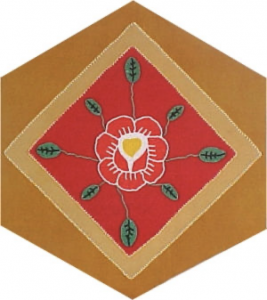Ojibwe

The Block
Marlene Shawanda, a mother of two and a beadwork designer in Wikwemikong on Ontario’s Manitoulin Island, chose the Ojibwe rose to represent her people. Bright coloured beads in white, red and yellow create the image of a rose set against a background of red felt, bordered by caribou hide. Reaching out from the rose are stems and leaves, each one indicating a cardinal point of the compass. The Ojibwe rose is a pattern used traditionally by women, as they whiled away cold winter nights. Snug and warm beside the fires inside their wigwams they intricately sewed quill and moose-hair to brightly dyed moccasins. The work was made less tedious by storytelling, sparking laughter and a nurturing a sense of community.
Cultural Profile
Once the largest and most powerful tribe around the Great Lakes, the Ojibwe are now spread from Ontario to Alberta, and across the border into the United States. A semi-nomadic woodlands people, they expanded their territory west of Lake Superior as far as Wisconsin, coming into conflict with the Dakota Sioux. Moving south and east into Upper Michigan and southern Ontario, they also clashed with the Iroquois. Bands that had moved westward eventually adopted a plains lifestyle.
The Ojibwe language is of the Algonquian linguistic family and their name comes from the Algonquin word otchipwa, meaning “to pucker”. The name refers to the particular style of mocassin made by the Ojibwe with a puckered seam. In Canada, however, many Ojibwe refer to themselves as Anishnabé or Anishinaabé, which means “original men,” or simply “people.”
The Ojibwe were the Faith Keepers of the Three Fires Confederacy, along with the Odawa (the Traders) and Powtawatomi (the Fire Keepers). The Confederacy was centred on Manatoulin Island in Wikwemikong, or “bay of the beavers”. Oral tradition maintains that this was the place from where the beaver originated and spread across Canada.
When not busy harvesting wild rice and berries, fishing, or hunting large and small game, the Ojibwe passed along their beliefs and values through stories and legends. Often the stories were humorous, a trait for which the Ojibwe were well-known. The arrival of spring set the sap to running and the Ojibwe became busy tapping the trees to collect their most precious seasoning, before the introduction of salt. They also used maple syrup for making sugar cakes and candy. They grew what are called The Three Sisters: corn, beans, and squash, to supplement their diet. Birch bark was used to fashion everything from utensils and storage containers to canoes and wigwam coverings.
Along with other members of the Three Fires Confederacy many Ojibwe live on the Wikwemikong Unceded Indian Reserve No. 26 on Manitoulin Island. Here they continue to practice their traditional ways integrating them into a modern lifestyle. Although preparation methods have changed, traditional foods are still available, especially during social gatherings such as dances, ceremonies, and sweat lodges. Annual pow-wows are much-anticipated events celebrating a vibrant and proud culture through song and dance, shared with both natives and non-natives alike.
Sponsor: Adam Beach & Tara Mason
